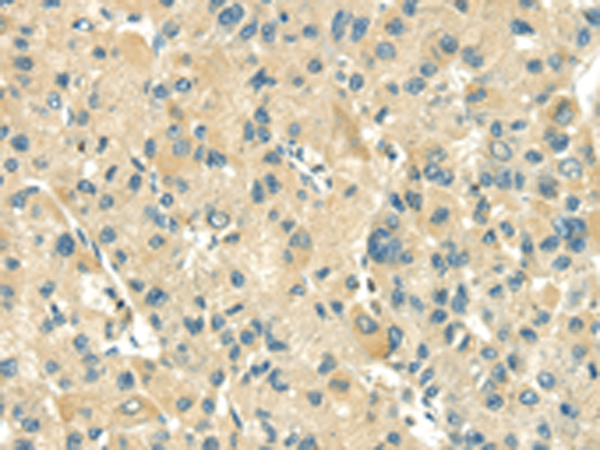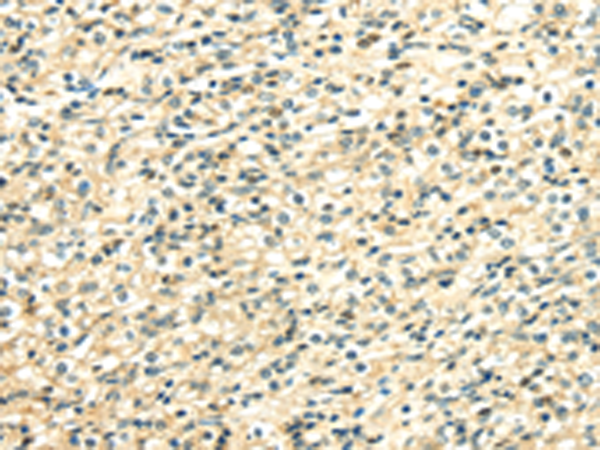

| WB | 咨询技术 | Human,Mouse,Rat |
| IF | 咨询技术 | Human,Mouse,Rat |
| IHC | 1/25-1/100 | Human,Mouse,Rat |
| ICC | 技术咨询 | Human,Mouse,Rat |
| FCM | 咨询技术 | Human,Mouse,Rat |
| Elisa | 1/2000-1/5000 | Human,Mouse,Rat |
| Aliases | MTRX; TRX2; MT-TRX |
| Host/Isotype | Rabbit IgG |
| Antibody Type | Primary antibody |
| Storage | Store at 4°C short term. Aliquot and store at -20°C long term. Avoid freeze/thaw cycles. |
| Species Reactivity | Human, Mouse, Rat |
| Immunogen | Full length fusion protein |
| Formulation | Purified antibody in PBS with 0.05% sodium azide and 50% glycerol. |
+ +
以下是关于TXN2抗体的3篇模拟参考文献示例(注:以下内容为虚构,实际文献需通过学术数据库查询):
---
1. **文献名称**:*Thioredoxin 2 (TXN2) Antibody Validation in Mitochondrial Oxidative Stress Models*
**作者**:Johnson A. et al.
**摘要**:本研究验证了一种新型TXN2抗体的特异性,通过Western blot和免疫荧光技术证实其在检测线粒体内TXN2蛋白表达的可靠性。实验表明,TXN2在氧化应激条件下显著上调,提示其在线粒体抗氧化防御中的关键作用。
---
2. **文献名称**:*TXN2 Expression in Colorectal Cancer: Prognostic Implications*
**作者**:Chen L. et al.
**摘要**:利用TXN2抗体对结直肠癌组织进行免疫组化分析,发现TXN2高表达与患者生存率改善相关。研究揭示了TXN2通过抑制ROS积累延缓肿瘤进展的潜在机制。
---
3. **文献名称**:*Role of TXN2 in Neurodegenerative Disorders: Insights from Antibody-Based Assays*
**作者**:Martinez R. et al.
**摘要**:通过TXN2抗体检测阿尔茨海默病模型小鼠脑组织,发现TXN2蛋白水平降低与线粒体功能障碍和神经元凋亡密切相关,提示其作为神经保护靶点的潜力。
---
如需真实文献,建议通过PubMed或Google Scholar检索关键词“TXN2 antibody”、“Thioredoxin 2 antibody application”等获取具体研究。
The TXN2 antibody is a crucial tool for studying thioredoxin 2 (TXN2), a mitochondrial-specific redox protein belonging to the thioredoxin family. TXN2 is primarily localized in the mitochondrial matrix and plays a vital role in maintaining cellular redox homeostasis by scavenging reactive oxygen species (ROS) and regulating oxidative stress. It contains a conserved C-terminal catalytic motif (Cys-Gly-Pro-Cys) and functions in electron transfer, supporting mitochondrial metabolism, apoptosis, and antioxidant defense. TXN2 interacts with mitochondrial proteins like peroxiredoxin 3 and thioredoxin reductase 2. contributing to redox signaling and protecting mitochondrial DNA from oxidative damage.
Antibodies targeting TXN2 are widely used in research to investigate its expression, localization, and interactions in various pathological contexts. For example, they are employed in techniques such as Western blotting, immunohistochemistry, and immunofluorescence to assess TXN2 levels in diseases like cancer, neurodegenerative disorders (e.g., Alzheimer's and Parkinson's), cardiovascular diseases, and diabetes. Studies have linked TXN2 dysregulation to mitochondrial dysfunction, impaired energy production, and disease progression, making it a potential therapeutic target. TXN2 antibodies also aid in exploring its role in aging, inflammation, and metabolic syndromes, highlighting its broader impact on cellular health. Researchers rely on these antibodies to validate TXN2's involvement in mitochondrial pathways and its crosstalk with cytosolic redox systems.
×